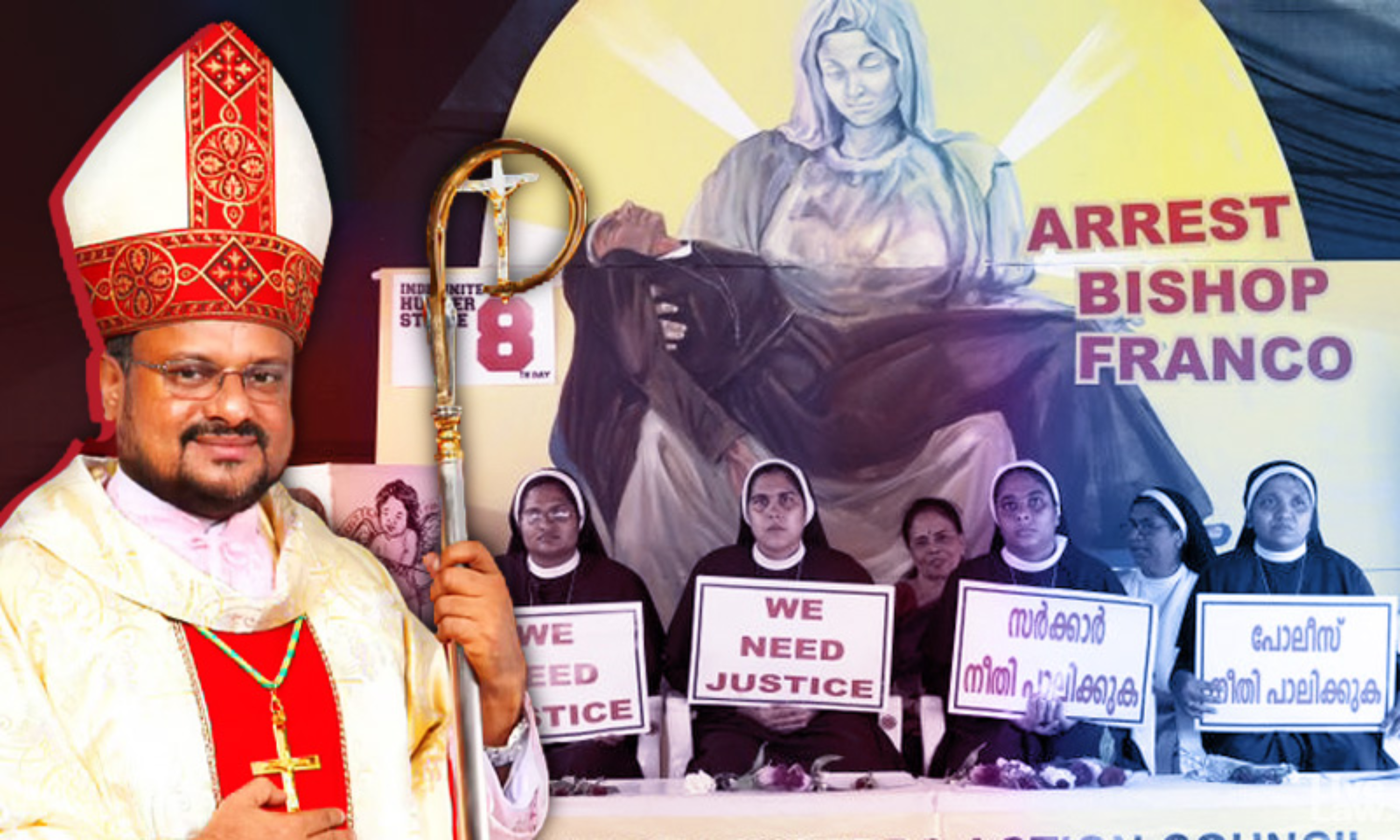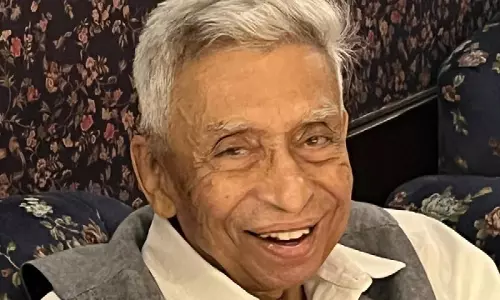Why Bishop Franco Mulakkal's Acquittal In Nun Rape Case Is Flawed?
The Trial Court adopted a technical approach without appreciating the constraints under which a nun lives and the power dynamics involved in the case.;

The trial court which acquitted Catholic Bishop Franco Mulakkal in the nun rape case applied a wholly unrealistic standard while discarding the testimony of the victim in its entirety. The Additional Sessions Court at Kottayam ignored certain well-settled principles of appreciation of evidence and adopted an approach that did not take into account normal human conduct.The primary flaw in...
To explain this principle, a quote from a Supreme Court precedent(Ranbir v. State AIR 1973 SC 1409 is useful :
"Even if major portion of evidence is found to be deficient, in case residue is sufficient to prove guilt of an accused, his conviction can be maintained. It is the duty of the Court to separate grain from chaff. Where chaff can be separated from grain, it would be open to the Court to convict an accused notwithstanding the fact that evidence has been found to be deficient, or to be not wholly credible. Falsity of material particular would not ruin it from the beginning to end".
The Supreme Court has said in another case that "if a whole body of the testimony were to be rejected, because witness was evidently speaking an untruth in some aspect, it is to be feared that administration of criminal justice would come to a dead stop" (Gurucharan Singh and Another v. State of Punjab, AIR 1956 SC 460). This approach is based on a pragmatic and realistic understanding that "one hardly comes across a witness whose evidence does not contain a grain of untruth or at any rate exaggeration, embroideries or embellishment".
However, in the Bishop Franco case, the Additional Sessions Court at Kottayam threw out the nun's evidence wholly by saying that it was unbelievable on some counts. The Court said it was not possible to separate the "grain and chaff" and the only option was to discard the evidence totally. This is what the Court observed :
"…when it is not feasible to separate truth from falsehood, when grain and chaff are inextricably mixed up, the only available course is to discard the evidence in toto".
This quote is a paraphrased version of an obiter observation from the Supreme Court judgment in Jayaseelan versus State of Tamil Nadu AIR 2009 SC 1901. The exact wordings as stated by the Supreme Court are as follows :
"Where it is not feasible to separate truth from falsehood, because grain and chaff are inextricably mixed up, and in the process of separation an absolutely new case has to be reconstructed by divorcing essential details presented by the prosecution completely from the context and the background against which they are made, the only available course to be made is to discard the evidence in toto"(the highlighted portion omitted from the judgment).
It is a different thing that in the Jayaseelan case, the Supreme Court refused to reject a witness's testimony on the ground that it was false in some aspects. The consistent precedents dictate that it is the duty of the Court to separate the elements of truth and that it cannot give up that task by saying both are inseparable.
Does the exercise of separating "grain and chaff" in the victim's testimony in Franco case amount to the reconstruction of a new case so as to compel the discarding of the entire evidence, as observed by the Supreme Court? Let us analyze.
The improvement in the Section 164 statement (Trigger Warning: Disturbing descriptions of sexual crime)
The main point cited by the Court to discredit the nun is that she raised the allegations relating to penile penetration at a later stage only. In the complaint and the First Information Statement(FIS), she had not mentioned penile penetration. In the earlier disclosures made to other nuns, she had only said that the Bishop was forcing her to "share the bed with him" and no mention of rape was made.
This is what the Court recorded :
"In Ext.P1 FIS she did not disclose about penile penetration. Her version was that the accused inserted his fingers into her vagina and that he attempted to thrust his sexual organ into her mouth and that she was forced to hold his sexual organ….
In her additional statement and Sec.164 statement her version was that she was subjected to forcible sexual intercourse including penile penetration on 12 occasions and that there was only fingering on the first occasion".
The Court did not accept the explanation of the nun that she did not feel comfortable sharing the details with the Woman Police Officer at the time of FIS and the statement was recorded in an "unsecured environment".
FIR need not be an "encyclopedia of facts"
In this connection, it is important to refer to the well-settled principle that an FIR is not supposed to be an "encyclopedia of facts". It means that it need not contain all minute details relating to the offence. It only needs to contain the basic ingredients of the offence. A Court cannot reject the prosecution case as given in the FIR merely because of some omissions(see: Motiram Padu Joshi v State of Maharashtra, (2018) 9 SCC 429). It is also not to be ignored that the FIS and Section 164 statement are not substantive pieces of evidence and have only corroborative value.
Bishop Franco Mulakkal Case : Why Court Found Nun's Testimony Unreliable?
Disclosure to nuns
Before taking this discussion further, it is relevant to refer to the disclosure made to a nun in 2014, which, in the humble opinion of this author, was treated in an utmost casual manner by the Court.
It may be recalled that the first instance of the sexual assault by the Bishop, as alleged by the nun, happened on 05.05.2014. The offence was repeated again on the next day, 06.05.2014.
The nun told the Court that she had disclosed these incidents to Sister Lizzy Vadakkel of Franciscan Clarist Congregation (FCC), who she calls her "spiritual mother". She could not recollect the exact dates of disclosures but said that they were made, either in the end of 2014 or in the beginning of 2015. Sister Lizzy, who was examined as PW2, corroborated this fact before the Court.
But the Court disbelieved Lizzy on the ground that the victim had not disclosed the subsequent sexual assaults which happened in 2015 and 2016 to her, although both of them were in regular contact.
This is what the Court had to say :
"If PW2 was in fact acting like as a spiritual mother of PW1, she would have definitely disclosed these incidents to PW2, regularly"
"PW2's version before this court and the Magistrate will not prove that PW1 disclosed to her about any of the incidents after 2015".
Further, the fact that the victim did not mention the disclosure to PW2 in the FIS was also cited as a ground by the Court to disbelieve her. The Court also highlighted certain incorrect facts in the letter written by Sister Lizzy to her Provincial Superior Sister Alphonsa to discredit her testimony. Sister Lizzy told the Court that she had deliberately written certain incorrect facts as she apprehended adverse action from her superiors. She also exclaimed in the Court that she felt her head fainting on knowing that her letter has been given to the lawyers of the accused(It may be noted that in 2019, Sister Lizzy had to face transfer order in her congregation, after her statement against Bishop Franco). Sister Lizzy has said that she is devastated to know that the letter which was sent by her to ensure her survival in the congregation has been used by Franco's lawyers.
The question which arises here is whether these factors are sufficient to discredit the evidence when Sister Lizzy –who as a nun was braving a lot of odds by going against the congregation- stood firm that the victim made the disclosures about the sexual acts forced on her in 2014. Remember, the victim needs to prove only a single instance of forcible sex to secure a conviction against the accused.
"Will have to share bed with him" : Disclosures to other nuns.
In September 2016, the victim made certain disclosures to Sister Neena Rose and Sister Anupama, who were examined as PW3 and PW4 respectively.
According to their testimony, after a retreat, they noticed the victim in a gloomy mood. When enquired about the reason, the victim spoke about the arrival of the Bishop in the convent in the coming days. PW3 and PW4 asked why the arrival of Bishop should be a cause of concern.
"If the Bishop comes, I will have to share the bed with him. I did not tell them that I have slept with him" – this is the English translation of testimony of the victim regarding the disclosure made to PW3 and PW4.
PW3 and PW4 stated in the Court that the victim had told them that the accused had raped her. According to the Court, there is a contradiction here as the nun had not told PW3 and PW4 that she had in fact slept with the Bishop. Therefore, how could PW3 and PW4 say that the victim had disclosed the rape which was committed on her? This was the Court's question. Here, it appears that the Court adopted an unrealistic approach.
When a person says with despair that she will "have to share the bed" with another (a person in authority), it is implicit in that statement that the person has been subjected to forcible sexual acts in the past and that the person apprehends the recurrence of such acts in the future. That is the common sensical understanding. From a lay perspective, it is unrealistic to expect a person to use the technical definition of rape in such a conversation.
It is natural for a person hearing such a disclosure to presume that "rape" (in the lay understanding) has happened. It is immaterial whether such understanding meets the legal definition of the offence under Section 375 IPC. What matters here is whether a disclosure was made and whether it is corroborated.
The Court also referred to a TV channel interview given by Sister Anupama to discredit her. In that interview, she had said that she came to know about the details of the crime only after the registration of the FIR. This is taken by the Court to make a conclusion that Sister Anupama was not aware of the incident in 2016 when the disclosure was claimed to have been made to her. Here again, the Court adopts an unrealistic approach. It is not difficult to understand that the victim had not disclosed the intricate details of the offences to the nuns. Remember, she is a nun, who is conditioned to believe in the virtue of chastity, and naturally, she will be hesitant in disclosing the minute details to others, especially to nuns who are junior to her.
The Court also picked on Anupama's statement in the interview that they would not have gone for the case had the matter been settled within the Church. It is difficult to understand how this can be adverse to her credibility. It is clear from the record that they had made several attempts to find a resolution to the issue within the system, as they did not want to infringe the reputation of the Church. After the attempts failed, they were forced to adopt legal means. It is a very conceivable and probable situation within the setting in which the nuns live.
The improvement in the statement regarding penile penetration
Now coming to the crucial point raised by the Court to discredit the victim – the improvement in the evidence regarding penile penetration. The Court also took note of the striking off in the statement given to the doctor that there was no penile penetration.
Let us assume for the argument sake that the victim indeed made a subsequent exaggeration in the statement to allege penile penetration. The striking point here is that even going by her First Information Statement, which alleged insertion of fingers into private parts, the ingredients of the offence of rape have been made out. It may be recalled that after the 2013 amendment to Section 375 IPC, the scope of rape has been expanded to cover non-penile penetrations as well. So, even in the first statement, the ingredients of the offence are there. She would not have gained anything by making a false improvement in the statement later. It is true that had she disclosed the penile penetration on the first occasion itself, it would have secured the credibility of the allegation. But in any case, her first set of allegations constituted Section 375 IPC. We don't know what were her motivations in holding back that aspect. Perhaps, it is where the stigma in the mind of a nun becomes relevant. Unfortunately, the Court did not make an endeavour to approach the issue from this perspective.
The Court ought to have been more empathetic about her circumstances and ought to have endeavoured to find out if her testimony could have been accepted at least in part, regardless of the improvement. In the Jayaseelan case quoted by the Court, the Supreme Court said that the evidence need to be thrown out if the separation of grain and chaff would amount to the "reconstruction of a new case". Here, even if the improvement is omitted, the offence under Section 376IPC stands. There is no "reconstruction of a new case" here.
Was the victim expected to narrate all graphic details of sexual crimes in her internal complaints?
It is clear from the facts that the nun had been pursuing her complaints against Bishop Franco with various church authorities at different stages, before taking the last resort of approaching the police. The Court places considerable weightage on the fact that the nun did not expressly mention "rape" in her complaints.
The Court recorded that in her initial revelations, the allegation was that the accused was forcing her to "share a bed" with him and no allegations of rape or sexual violence were raised then, the Court notes.
"Her revelation to PWs 3 and 4 during December 2016 was that Bishop is forcing her to share bed with him. She did not disclose to them that she was subjected to sexual violence on 13 occasions"
Another example, the Court says :
"Her version to PW6, Bishop Kurain Valiyakandathil was that accused is taking retaliatory measures for not sharing bed with him and not that she was raped or sexually abused".
Another extract from the judgment :
"In Ext.P13 letter sent to Cardinal Marc on 14.05.2018, her version was that the accused abused her for the first time on 05.05.2014. It was also stated in the said letter that the abuse continued for several times. But it is not specified that she was raped on 13 occasions".
It appears that the Court has taken the words "sharing bed" quite literally without understanding the intent with which the words have been used. The Court appears to be adopting a highly unrealistic standard, which is totally out of tune with normal human conduct.
Character trial
The Court goes to lengths to discuss the evidence of one Jaya (PW16), a cousin of the victim, who had sent a complaint to the congregation in 2017 that the victim was involved in an affair with her husband. It is relevant to note that the complaint of Jaya emerged after the victim allegedly started resisting the sexual advances of the accused. However, before the Court, Jaya gave up the complaint and stated that it was false. Despite that, the Court took pains to establish that the complaint was possible, suggesting some sort of relationship between the nun and her cousin's husband.
The big question which stares at us here is- what is the relevance of this? How does it matter if the victim had another affair? While discussing Jaya's complaint, the Court even details the breast examination of the victim. It seems both the character and body of the victim were put on trial!
The Court also mentions certain e-mail exchanges between the accused and the victim and the details of their travel together to suggest that they were on friendly terms during the period. The Court ignores the angle of fiduciary relationship existing between them on account of the religious authority of the accused over the victim(elaborated in detail later). Also, it appears that the Court was swayed by certain stereotypes about rape-victim behaviour.
The Supreme Court has time and again reminded that the Courts should avoid stereotypical thinking and myths about "moral" and "conduct" of rape victims while deciding rape cases(See the 2021 judgment in Aparna Bhat case).Expressing concerns about "judicial stereotypes", the Supreme Court had observed in Aparna Bhat case:
"The stereotype of the ideal sexual assault victim disqualifies several accounts of lived experiences of sexual assault. Rape myths undermine the credibility of those women who are seen to deviate too far from stereotyped notions of chastity, resistance to rape, having visible physical injuries, behaving a certain way, reporting the offence immediately, etc".
The Court's discussions on the character of the victim violate Section 53A of the Indian Evidence Act, which state that in rape cases, the character and past sexual experiences of the woman are irrelevant. It is also to be noted that sub-section (4) of Section 155 of the Indian Evidence Act, which had permitted the use of character evidence to discredit the prosecutrix, has been omitted from the statute after the 2003 amendment. But the judgment in effect allows the operation of this omitted provision.
The judgment also had a touch of irony when it stated that the bad character of the accused was irrelevant, after making sweeping findings about the character of the victim. Of course, Section 54 of the Indian Evidence Act says that the bad character of the accused is irrelevant unless the accused gives evidence regarding his good character. Here, the Bishop had not led any evidence regarding his good character and his bad character was irrelevant. One nun, who testified as PW8, had deposed before the Court that the Bishop had inappropriately touched her. The Court discarded this as irrelevant. Certainly, the Court cannot be faulted here in view of Section 54 of the Evidence Act. Yet, in a different sense, the irony was too stark to miss.
Power imbalance not appreciated
One cannot lose sight of the fact that the accused was in a position of authority over the victim. The victim's position compels her to obey him. The Court has not analyzed the issue from the perspective of a fiduciary relationship between the accused and the victim.
It is to be noted that along with rape, the accused was charged under Section 376C of the IPC, which deals with the offence of sexual intercourse by a person in authority. The offence penalizes a person who "abuses such position or fiduciary relationship to induce or seduce any woman either in his custody or under his charge or present in the premises to have sexual intercourse with him".
The Court has made a finding that the accused was in a position of authority over the nun, as an answer to Point 1. Although the Court makes hints at a possible relationship between them, it did not care to analyze if there was an element of abuse of authority by the accused. There is absolutely no discussion in this regard. It may be noted that in the beginning paragraph of the judgment, there is a narration regarding the accused directing the victim to bring his cassock ironed. There is also a mention about the victim and another nun carrying the luggage of Bishop from the car. That the victim, who was the mother superior of the convent, had to take his orders to iron his cassock and carry his luggage throw considerable light on the degree of the power imbalance between them. It is important to note that the accused is not just a person in a superior hierarchy, he occupies a divine status of "good shepherd" and going against him would be seen as going against the divine power. A nun takes the vow of obedience while joining the convent. Saying 'No' to superiors is not an option available to her. The Court also finds that the Bishop had stayed in the convent on two days, 05.05.2014 and 06.05.2014, by ruling out his plea of alibi.
There are several precedents that hold that consent obtained by abusing authority or fiduciary position is not valid consent. Section 114A of the Evidence Act presumes the absence of consent in rape cases. There is no meaningful discussion in the judgment on these aspects.
The Court also devotes much importance to the prosecution not producing the mobile and laptop of the victim, which could have proved the obscene messages alleged to have been sent by the Bishop. The consequence of this ought to have been that the obscene messages are not proved. Beyond that, it is incomprehensible how this lapse can discredit the evidence.
Proactive approach by the Court was lacking
In the Walayar rape case, the Kerala High Court said that Trial Courts must take a proactive role at the time of taking evidence and that there should be serious engagement in discovering the truth, rather than remaining as a "mute spectator". The present case had several unique features, which called for a different approach. It ought to have been appreciated that the prosecutrix was a nun, who will face something similar to a "civil death" on expulsion from the congregation. She had to fight several battles before approaching the legal system. The accused was powerful and had the backing of strong quarters of the society, whereas the victim and the witnesses supporting her faced extreme social hostilities. For a woman conditioned to a cloistered and submissive life, coming out in public with these allegations must have been an unbearable ordeal. The inaccuracies and shortcomings in the evidence ought to have been appreciated in the light of the power dynamics and uneven level field in the case. Unfortunately, by saying that it was impossible to separate the "grain" from the "chaff", the Court abdicated its judicial functions. A disastrous fall-out of the judgment will be that it will encourage the "culture of silence" regarding sexual crimes and might deter women from going against men occupying powerful positions.




